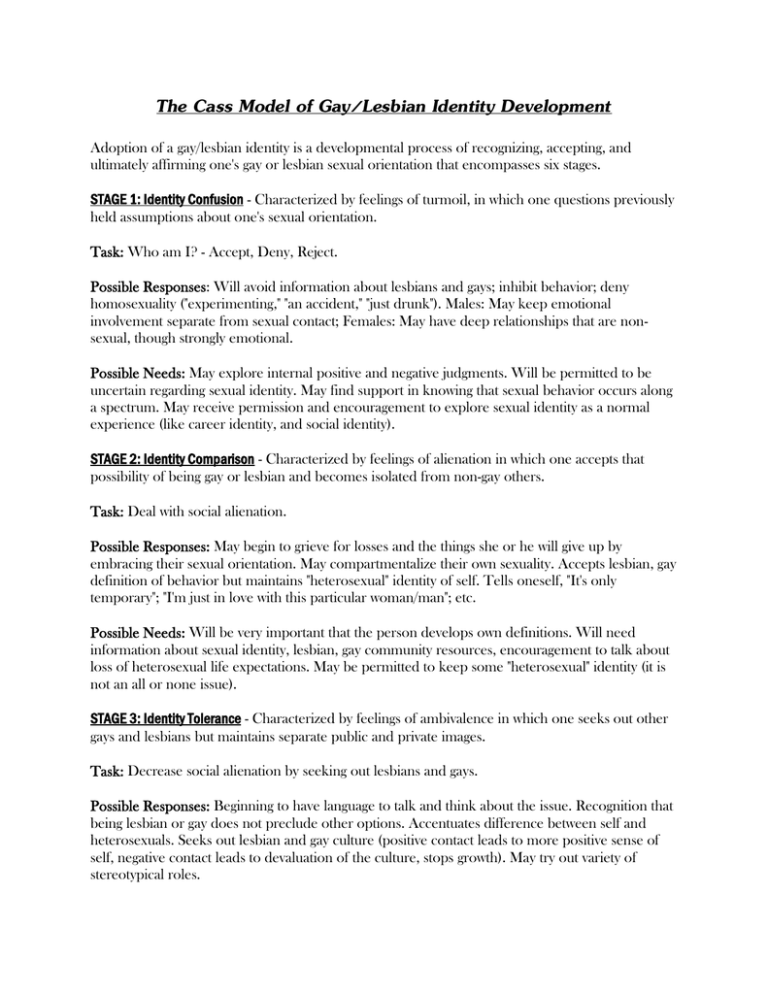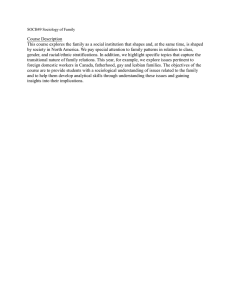
The Cass Model of Gay/Lesbian Identity Development
Adoption of a gay/lesbian identity is a developmental process of recognizing, accepting, and
ultimately affirming one's gay or lesbian sexual orientation that encompasses six stages.
STAGE 1: Identity Confusion - Characterized by feelings of turmoil, in which one questions previously
held assumptions about one's sexual orientation.
Task: Who am I? - Accept, Deny, Reject.
Possible Responses: Will avoid information about lesbians and gays; inhibit behavior; deny
homosexuality ("experimenting," "an accident," "just drunk"). Males: May keep emotional
involvement separate from sexual contact; Females: May have deep relationships that are nonsexual, though strongly emotional.
Possible Needs: May explore internal positive and negative judgments. Will be permitted to be
uncertain regarding sexual identity. May find support in knowing that sexual behavior occurs along
a spectrum. May receive permission and encouragement to explore sexual identity as a normal
experience (like career identity, and social identity).
STAGE 2: Identity Comparison - Characterized by feelings of alienation in which one accepts that
possibility of being gay or lesbian and becomes isolated from non-gay others.
Task: Deal with social alienation.
Possible Responses: May begin to grieve for losses and the things she or he will give up by
embracing their sexual orientation. May compartmentalize their own sexuality. Accepts lesbian, gay
definition of behavior but maintains "heterosexual" identity of self. Tells oneself, "It's only
temporary"; "I'm just in love with this particular woman/man"; etc.
Possible Needs: Will be very important that the person develops own definitions. Will need
information about sexual identity, lesbian, gay community resources, encouragement to talk about
loss of heterosexual life expectations. May be permitted to keep some "heterosexual" identity (it is
not an all or none issue).
STAGE 3: Identity Tolerance - Characterized by feelings of ambivalence in which one seeks out other
gays and lesbians but maintains separate public and private images.
Task: Decrease social alienation by seeking out lesbians and gays.
Possible Responses: Beginning to have language to talk and think about the issue. Recognition that
being lesbian or gay does not preclude other options. Accentuates difference between self and
heterosexuals. Seeks out lesbian and gay culture (positive contact leads to more positive sense of
self, negative contact leads to devaluation of the culture, stops growth). May try out variety of
stereotypical roles.
Possible Needs: Be supported in exploring own shame feelings derived from both internal and
external heterosexism. Receive support in finding positive lesbian, gay community connections. It
is particularly important for the person to know community resources.
STAGE 4: Identity Acceptance - Characterized by selective disclosure in which one begins the
legitimization (publicly as well as privately) of one's sexual orientation.
Task: Deal with inner tension of no longer subscribing to society's norm, attempt to bring
congruence between private and public view of self.
Possible Responses: Accepts gay or lesbian self-identification. May compartmentalize "gay life".
Maintains less and less contact with heterosexual community. Attempts to "fit in" and "not make
waves" within the gay and lesbian community. Begins some selective disclosures of sexual identity.
More social coming out; more comfortable being seen with groups of men or women that are
identified as "gay". More realistic evaluation of situation.
Possible Needs: Continue exploring grief and loss of heterosexual life expectations. Continue
exploring internalized "homophobia". Find support in making decisions about where, when, and to
whom he or she self-discloses.
STAGE 5: Identity Pride - Characterized by anger, pride, and activism in which one becomes
immersed in the gay subculture and rejects non-gay people, institutions, and values.
Task: Deal with incongruent views of heterosexuals.
Possible Responses: Splits world into "gay" (good) and "straight" (bad). Experiences disclosure crises
with heterosexuals, as he or she is less willing to blend in. Identifies gay culture as sole source of
support; all gay friends, business connections, social connections.
Possible Needs: Receive support for exploring anger issues. Find support for exploring issues of
heterosexism. Develop skills for coping with reactions and responses to disclosure of sexual
identity. Resist being defensive!
STAGE 6: Identity Synthesis - Characterized by clarity and acceptance in which one moves beyond
the dichotomized worldview to an incorporation of one's sexual orientation as one aspect of a
more integrated identity.
Task: Integrate gay and lesbian identity so that instead of being the identity, it is on aspect of self.
Possible Responses: Continues to be angry at heterosexism, but with decreased intensity. Allows
trust of others to increase and build. Gay and lesbian identity is integrated with all aspects of "self."
Feels all right to move out into the community and not simply define space according to sexual
orientation.
Possible Needs: Allows trust of others to increase and build. Gay and lesbian identity is integrated
with all aspects of "self." Feels alright to move out into the community and not simply define space
according to sexual orientation.
**Source: Adapted from Cass, V. Homosexual Identity Development, 1979.

![-----Original Message----- [mailto:] Sent: Monday, March 14, 2005 1:40 PM](http://s2.studylib.net/store/data/015588373_1-7bff81458ec3f7ba2c91b69016705723-300x300.png)

![-----Original Message----- From: Rebecca Snarski [ ]](http://s2.studylib.net/store/data/015587796_1-276659ecf7bb177fecf464a302d19439-300x300.png)